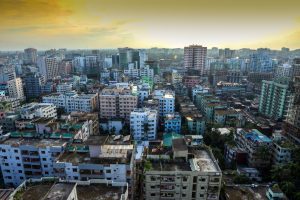Bangladesh has been a major beneficiary of globalization. The country has benefitted from the outsourcing of production to places where it can be done in a more cost-effective way. The ready-made garments (RMG) industry is labor intensive and labor is available in Bangladesh in abundance at a cheap price. The abundance of labor has also made Bangladesh a major labor exporting country, bringing valuable foreign exchange. It also helps in the balance of payment situation. The political stability in Bangladesh in the last decade and propitious circumstances brought on by globalization has resulted in very fast economic growth in the country. Bangladesh’s GDP growth in last few years has averaged around 8 percent. This was happening at a time when economic growth in rest of the world was slowing down. However, this fast economic growth has been disrupted by the outbreak of the COVID-19 pandemic.
The RMG industry and remittances from overseas workers are the two biggest contributors to Bangladesh’s foreign exchange reserve. Manufacture and export of RMG contributes 13 percent to the GDP of the country. It employs nearly 4 million workers. It is estimated that out of this 1 million workers are already unemployed.
For the RMG industry, major export destinations include the United States, U.K., Germany, France, and Italy. However, garment stores in these countries are now shut. People have already limited their discretionary spending. Exporters in Bangladesh are now not getting their payments on time. Buyers are cancelling or modifying orders. As a result of this, industry owners are finding it difficult to pay salaries to workers. Laid-off workers are returning to villages, creating additional problems in the rural economy. The unemployment of these workers and the shutdown will create further problems in the realm of food security.
Remittances are another major source of foreign exchange. According to World Bank data, Bangladesh received $15.5 billion in remittances in 2018, 15 percent higher compared to the previous year. In 2017, Bangladeshi migrant workers sent $13.5 billion back home. Bangladesh was the third highest recipient of remittances in South Asia in 2018, after India and Pakistan, and the 11th highest recipient globally.
Nearly 10 million Bangladeshis are working in foreign countries. Most of them are in Gulf countries, Western countries, and some Southeast Asian countries like Malaysia. A large number of these workers are now returning home because of the disruptions in their host countries. Many host countries now have travel restrictions and economic slowdowns of their own. These returnees generate additional problems, both with regard to possible new infections and the economy. They also won’t be able to return to their usual places of work abroad until the global situation improves.
Pohela Boishakh — the Bangladeshi New Year — is usually a time when business is brisk in Bangladesh. This is when people do a lot of shopping. Unfortunately, because of the pandemic most people will not be able to do their shopping or celebrate as they normally would. This is going to affect the local economy in Bangladesh. Though some business owners are trying to shift online, in Bangladesh especially this won’t be enough to replace empty marketplaces.
In early March, the Asian Development Bank (ADB) estimated that in the worst case scenario the gross domestic product of Bangladesh may contract by as much as 1.1 percent, wiping $3.02 billion off the $300 billion-plus economy. The ADB further estimated that in this scenario 894,930 jobs will be lost. Unfortunately, in Bangladesh the number of unemployed workers in the garment sector has already exceeded this figure.
The impact of the pandemic is also likely to be greater on Bangladesh because of its dependence on China. China is Bangladesh’s biggest trade partner and is the biggest source of imports including raw materials needed for its industries. China is now also emerging as an export destination for Bangladesh. Moreover, the major portion of tourist traffic in Bangladesh comes from China. The barriers to imports from China, the original epicenter of the virus, will hurt the export-oriented sectors and disrupt the supply chain. It will also affect the overall trade.
The Bangladesh government has come out with a massive stimulus package to check the impact of the pandemic. The stimulus package, to the tune of 727 billion Bangladeshi taka ($8 billion) was announced by Bangladesh Prime Minister Sheikh Hasina on April 5. The government initially declared a 50 billion taka ($5.9 million) emergency incentive package to support the export-oriented industry. Further packages were announced aimed at affected industries. The total stimulus package is worth nearly 2.52 percent of GDP.
Exports of RMG and the return of migrant workers to their host countries will depend on how quickly the situation improves in the world. As of now it is feared that the impact of the pandemic on the Bangladeshi economy will be enormous. The Economist Intelligence Unit (EIU) estimates that the GDP of Bangladesh for the next year could decline by about 4 percent. The stimulus package announced by the Bangladesh government is impressive but it remains to be seen how effective it will be given the culture of embezzlement and previous tendencies to grant loans to cronies and politically connected people.
Anand Kumar is an associate fellow at the Manohar Parrikar Institute for Defence Studies and Analyses, New Delhi, India.
































